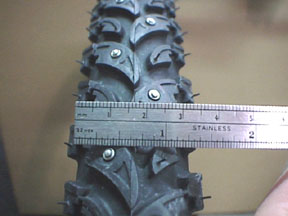benphyr
Guru-me-not
But can you add vision aids to detect the back ice, and improve wheel traction on a TWO wheeled vehicle!
I have studded tires on my mountain bike and ride year round.
(559 - 26" Nokian Hakkapeliitta W106 purchased many years ago at PeterWhiteCycles.com I highly recommend both these tires and Peter White cycles and their website is a wealth of knowledge.)

Yesterday had a lovely batch of “Christmas card” snow, huge flakes floating down that muffled sounds and gave a beauty rarely seen to the city.
If there is less than 1 inch of snow I rarely slide at all, up to 2 inches is usually fine, sometimes sliding but rarely falling, beyond that it has to be light and fluffy (usually fresh snowfall at -5*C or colder - did you know the Inuit have many, many words for snow similar to how we split up precipitation into rain, hail, and snow they have something like 20 different words. I digress - back to usual programming) otherwise it takes too much energy to push through and enough speed to keep going is beyond my watt output and not enough energy is left for balance. Usually the roads are cleared before I need them and between snowfalls and we don't rarely get enough to force me to find alternative transportation.
Yesterday morning I slid on a sidewalk transition which is an off camber corner onto a sidewalk ramp with the front tire - not true ice but probably some of that instantly compacted wet ice/snow fell then another 1 1/2 inches of snow on top. The front tire started to slide, I stood up, took my inside foot off the pedal ready to touch down, and as my weight shifted towards the front and inside the tire, especially the studs (I could hear them scraping) grabbed - not instantaneously but a controlled skid back into control. All this took a fraction of a second and was subconscious reaction.
True black ice can be a killer because of the unseen nature of it - iced puddles underneath fresh snow has a similar effect. However, studded tires do an amazing job of increasing traction if there is ANY texture or even without texture as long as you are riding cautiously - riding aggressively is for specific non-traffic conditions and where there is no chance of ice. Black ice changes the equation by changing the conditions without letting the rider/driver know... Better to be safer than sorrier. When you find yourself beyond conditions the best is straight line, no or gentle changes only - easy to say very hard to do. Remember if you have traction control, ABS brakes, etc. etc. those are backup plans to hopefully help when we mess up or overreact.
Remember that this is a mountain bike and setup that I have ridden for many winters. With care and knowledge of what is going on under the snow and recognition of how much traffic you are going to encounter (they are more dangerous than you on a bike) you can decide and ride safely most of the time. If you don't have a safe route then don't ride.) And take @superslim tire pressures seriously - you want contact patch in winter.
Please note: I am called crazy at work every day that I ride in snow (which is every day it that there is less than 2" )fresh) snow on the roads). But there is an awful lot of beauty and fun in the snow that jus has to be experienced to be understood.



We have special summer Lycra for arms, legs and especially heads, that hold the water within the Lycra, for minimum water use, and max cooling!
Please do expand with examples / pictures. Is there any to replace face sunscreen!!!
Last edited:




